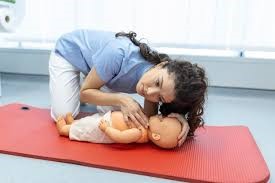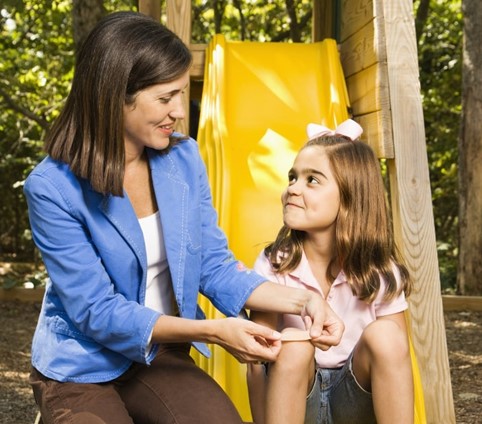Picture this: a child in your care suddenly starts showing signs of an asthma attack, or perhaps a severe allergic reaction. Would you know what to do? Are you aware of the common asthma symptoms?
As a childcare worker or educator, mastering first aid skills can mean the difference between life and death in emergency situations.
So, let’s dive in and explore the importance of first aid training for childcare and education workers. We’ll outline training options and formats, as well as some of the critical skills involved, such as CPR and the management of common childhood emergencies such as asthma and anaphylaxis.
The Importance of First Aid Training for Childcare Workers
First aid training is vital for childcare workers, not just to comply with legal requirements, but also to effectively manage potential emergency situations in their professional environment.
Being well-versed in first aid also empowers education and childcare workers to be more aware of potential hazards and take the necessary steps to avoid accidents. Furthermore, first aid skills can enhance childcare workers’ personal and professional development, leading to improved morale and better preparedness in their daily roles.
Legal Requirements
In the Australian context, childcare workers are required to have an approved first aid qualification, anaphylaxis management training, and emergency asthma treatment management training. At least one staff member or nominated supervisor of the service must hold these current qualifications to ensure that qualified people are always available in case of an emergency, and ready to call triple zero (000), or 911 if needed.
Benefits of First Aid Skills
First aid skills provide childcare workers with the ability to:
- Evaluate emergency scenarios
- Perform CPR
- Use an AED
- Handle various situations with assurance
They can save lives by acting quickly and effectively in emergencies, administering the correct treatment, and seeking professional help when necessary.
Moreover, having first aid skills can boost confidence and safety awareness, leading to a more secure and nurturing environment for children. With proper first aid training, education and childcare workers can face emergencies head-on and provide the best possible care to the children in their care.
Learning First Aid for Education and Childcare: Course Options

If you’re considering first aid training for a workplace that supervises children, you’ll find various first aid training providers offering courses tailored to your needs. These providers offer both online and in-person training options, allowing you to choose a format that best suits your schedule and learning preferences.
Accredited Training Providers
When searching for a reputable first aid course provider, look for those offering accredited first aid training, with good reviews and a strong reputation. A prime example of a quality registered training organisation is first aid course Adelaide. Check out their course options to find out which training is best for you.
Selecting a trustworthy training provider guarantees that you receive top-notch first aid education and training.
Understanding the HLTAID012 Course

The HLTAID012 course is a nationally accredited certification for childcare and education workers in the Australian setting. It covers first aid, CPR, and common infant and child ailments.
Approved by the Australian Children’s Education and Care Quality Authority (ACECQA), this course ensures proper first aid response in emergency situations and fulfills the regulatory requirements for childcare workers.
What exactly does the course encompass, and what are the study options?
Key Topics Covered
In the HLTAID012 course, you’ll gain invaluable skills and knowledge on key topics such as:
- CPR techniques for adults, children, and infants
- AED use
- Managing common childhood injuries and illnesses
- The management of asthma and anaphylaxis emergencies
This thorough training will enable you to deliver basic emergency life support and manage life-threatening situations in a childcare setting with confidence.
Online and In-Person Training
First aid courses for childcare workers are offered in both online and in-person formats, allowing you to choose the training method that best suits your learning style and schedule. Online training provides flexibility, enabling you to learn at your own pace from the comfort of your home.
In-person training, on the other hand, offers a more hands-on experience, with practical assessments and the opportunity to ask questions and receive feedback from an instructor. Both formats are designed to give you the knowledge and capability to keep a child alive until expert medical help arrives.
Practical Skills and Assessments
Throughout a quality, accredited course, you’ll learn practical skills and undergo assessments designed to test your ability to provide first aid in an education and care setting. These practical skills and assessments include CPR techniques and the use of an AED.
We will now examine these crucial skills in more detail and discuss their application in real-life scenarios.
CPR Techniques

CPR (Cardiopulmonary Resuscitation) is a crucial life-saving skill that involves performing chest compressions and rescue breaths to help restore circulation and breathing. In the HLTAID012 course, you’ll learn CPR techniques for adults, children, and infants.
For adults, begin with chest compressions using a hand-over-hand technique on the center of the chest, compressing to about 1/3 of its depth. Aim for 30 compressions per minute, alternating chest compressions with mouth-to-mouth or mouth-to-nose rescue breaths.
For children and infants, the CPR techniques are similar, but with some modifications. Here’s what you need to do:
- For children, use a hand-over-hand technique.
- For infants, use two fingers on the center of their chest.
- In both cases, compress the chest to about 1/3 of its depth but with less force.
- Perform at least two minutes of uninterrupted CPR, alternating chest compressions with rescue breaths.
Ensure you’re compressing at a rate of 30 compressions per minute to provide effective life support.
If you want to learn to administer CPR effectively, follow the link to obtain a nationally recognised CPR certificate Adelaide.
Using an AED
An AED (Automated External Defibrillator) is a life-saving device used to deliver an electric shock to the heart, helping restore a normal heart rhythm during sudden cardiac arrest. In your first aid course, you’ll learn how to safely and effectively use an AED in an aid emergency. AEDs are very user friendly, simply turn it on and follow the voice prompts.
Managing Asthma and Anaphylaxis in a Childcare Setting
Asthma and anaphylaxis are common medical emergencies that can occur in childcare settings. In your first aid course, you’ll learn how to recognize symptoms, provide appropriate first aid, and understand management plans for these conditions.
Understanding the right course of action in an emergency will bolster your confidence in managing asthma and anaphylaxis situations.
Asthma First Aid Steps
When managing asthma in a childcare setting, it’s crucial to help the child sit up, administer reliever medication, and seek medical help if needed, especially when there’s little or no relief. Recognizing the symptoms of an asthma attack, such as wheezing, coughing, chest tightness, and difficulty breathing, can help you take the necessary asthma first aid steps to alleviate the child’s distress and ensure their safety.
Anaphylaxis Management
Anaphylaxis management involves recognizing symptoms, administering an EpiPen, and seeking emergency medical assistance. Symptoms of anaphylaxis include difficulty breathing, swelling of the face, lips, tongue, and throat, hives, itching, nausea, vomiting, and dizziness.
Summary
In conclusion, first aid training is an essential component of childcare and education settings, equipping workers with the knowledge and skills needed to confidently handle medical emergencies.
By completing accredited first aid training such as the Australian HLTAID012 course, childcare workers can meet legal requirements and acquire practical skills, such as CPR techniques and AED use, and learn to manage common childhood emergencies like asthma and anaphylaxis effectively.
If you found this article helpful, check out our blog on Saving Lives with the First Aid Recovery Position for more information.















